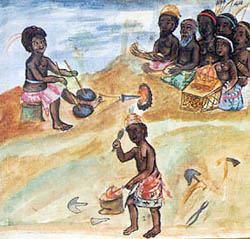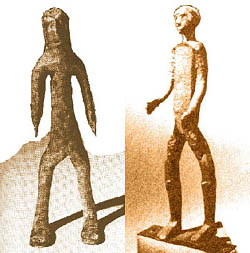Ironworkers

First king of “Ndongo” (Angola) forging weapons and utensils; in background (left) the use of bellows and (right) royal spectators.
African men with iron making skills were imported to the Chesapeake to work as blacksmiths on plantations and in the iron industry that, by the early 18th century, had begun to develop in Colonial America. Ironworkers were an elite group in West and West Central Africa, (de Barrios 2000:148; Barnes and Ben-Amos 1989). In West Africa, the rise of the Edo, Fon and a series of Yoruba kingdoms between 1400 and 1700, owed their political dominance to heavily equipped armies, using a highly developed iron technology. Blacksmiths are attributed central roles in the mythical origins of numerous West Central African and West African peoples.
The first southern ironworks was established in the Chesapeake. Alexander Spotswood, Lieutenant Governor Virginia erected the South’s first successful ironworks around 1718. There were at least 65 ironworks in the region employing as many as 4500 slaves. By 1775, the American colonies were the world’s third largest producer of iron. Built largely on slave labor, slavery played a crucial role in the growth and development of the industry. By the 1750s, enslaved men performed most of the skilled and manual labor. The most skilled African American artisans worked independently in positions of authority like Abraham and Bill, who in the 1760s, helped manage the Snowden iron furnace in Anne Arundel (Kulikoff 1986:413). Forges and furnaces employed between thirty and fifty slaves (Lewis 1974:242–243). Principio Ironworks owned slaves and livestock. When the British confiscated Principio Ironworks at the end of the American Revolution, it had been in gradual decline for thirty years, nevertheless it listed 136 slaves among its property.
Archeologists unearthed the remains of 31 enslaved ironworkers at the Catoctin Furnace in Maryland. Physical anthropologists at the Smithsonian Institution determined there was no European mixture among the group—they were first or second generation West Africans (Libby 1992; Catoctin Furnace 2003). Libby speculated that the Catoctin Furnace ironworkers like other African ironworkers of the period had been imported specifically to forge iron (Libby 1992). There is some evidence to support Libby’s hypothesis that slave traders valued Africans with skills or at least those from iron-producing regions who might possess skills. There also exists limited evidence that some slaves practiced their native skills in America. A 1760 newspaper advertisement, for instance, reports a runaway slave:
“[I]imported in 1760, so that he scarcely speaks any English, but can work at the Smith’s trade, having been employed in his own Country in that way.” (Maryland Gazette (Green), Annapolis, August 27, 1761 Geography of Slavery 2004).
Ironworkers in the Chesapeake were the most privileged of African and African American workers. They were paid for work done on their own time and could make purchases at company stores. Since forges and furnaces required waterpower, they closed down when water was in short supply due to drought or freezes. At the Snowden ironworks, enslaved artisans worked an average of 250–275 days a year, the equivalent of 5 days a week (Lewis 1974).
Ironworkers were provided opportunities for “overwork”—that is, working overtime in return for cash or supplies. The money allowed ironworkers and their families an improved standard of living. In addition, ironworkers did not experience strict control over their free time, home life, or leisure activities. These factors contributed to a stable family structure among enslaved ironworkers (Lewis 1978). In the early days of the new republic, shortly before the War of 1812, David Ross, owner of the Oxford Iron Works of Virginia Furnace, encouraged enslaved men to train their sons and other young male relatives in the ironworking trade (Bezia-Selfa 1999:685).
Women also worked at Chesapeake furnaces and forges. Women made up half the human remains excavated from the slave cemetery at Catoctin Furnace, Maryland. Although they had lived longer than most enslaved Africans had in those days, the men were an average of 41.2 years old when they died and the women 34.6 years. Using coffin nails, the date of their burial was calculated and the mean year of the burials was 1800. About 90 people were buried at the site but only 31 were evaluated (Brunston, 1981; Kelley and Angel, 1983; Libby 1992; Wehrle 2002). In 1811, ten or 30% of the 29 women working at the Oxford Iron Works, worked at the furnace, (3) at the coaling grounds and (1) at the ore banks. Aside from the African women workers at Oxford Ironworks and Catoctin Furnace, fifteen enslaved women worked at Snowden ironworks in Virginia. The Oxford women were wives or daughters of furnace men (Lewis 1979; Kulikoff 1984:415; Bezis-Selfa 1999). Men in West and West Central African societies traditionally performed smelting and smithing. Women and children often performed labor-intensive tasks not directly associated with actual iron working such as mining ore, charcoal and clay preparation and transport. These were similar to women’s roles in Chesapeake ironworks (de Barrios 2000:51).
Blacksmiths have traditionally occupied a unique and powerful position in Mande social organization since at least the 13th century founding of the Mali Empire. Politically and socially, Mande blacksmiths were extremely powerful, offering invaluable counsel to the village chief concerning all major decisions. However, while revered and honored, the spiritual and ritual knowledge and activities of blacksmiths were also greatly feared. They were believed to control the natural forces intrinsic to all objects, a force the Mande call nyama, which is understood to be both energy and the explanation for the organization of the Mande world (Ross 2004).
Ironworkers’ activities were controlled by the ancestors and the spirits, and they communicated essential values and concerns to the larger group (Goucher 2001). According to Terry Childs, among the Bantu-speaking ironworkers, these messages were sent to the living and the spiritual worlds (1991:353). Childs also notes that prominent master smelters among Bantu-speaking men sought to expand their influence and productivity that were stepping stones to political leadership (Childs 1991:351).

(left) Eastern Bamana forged iron figure, no date.
(right) Iron figure from blacksmiths shop, slave quarters, 18th century Virginia.
There is evidence that suggests African ironworkers may have transferred old sacred beliefs associated with iron to the Americas along with the technology. Vlach reports finding a wrought-iron male figure, legs apart, arms bent reaching forward, under the dirt floor at the site of a blacksmith’s shop near slave quarters in Alexandria, Virginia. The artifact dates to late eighteenth century (Vlach 1978:136–138; Vlach Personal Communication 2004). The style of the figure resembles that of an undated Eastern Bamana iron figure. According McNaughton, blacksmiths made and buried such figures under their forges to protect them while engaging in their dangerous transformative craft that radically changes the order of materials, dirt (ore) becomes metal (McNaughton 1988). They believed the forces of nature were not pleased at this usurpation of their power and so the blacksmiths have to protect themselves by making a little watchman (Barnes and Ben-Amos 1989:53–59; de Barrios 2000:174–175).
Although enslaved in the American colonies, for ironworkers to be able to continue as a specialized professional group, probably reaffirmed their own sense of African identity, their social esteem and sense of personal agency. Learn more about African Iron technology in the Americas.
Transfer of African ironworking technology also took place in the forges of northern colonies. Pennsylvania ironmasters were the largest northern slave owners during the colonial period (Bezis-Selfa 1999).






